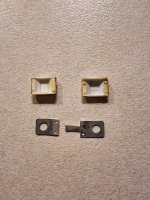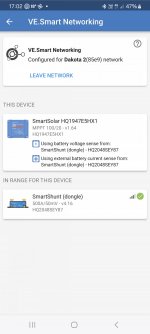Canalsman
Full Member
- Posts
- 6,138
- Likes
- 7,946
I admit I haven't done this for a couple of years..
I have a Victron-based setup, mostly installed a few years back by @wildebus , and a few days ago I noticed that the Lithium battery wasn't charging fully. The SmartSolar controller was going into float mode early with the battery at only 85% charged according to its BMS.
What I observed was that there was more than a volt difference between the voltage reported by the SmartSolar and the SmartShunt. From this I deduced high resistance in the charging circuit. I checked the connections at the SmartSolar and then the two fused connections in the external locker adjacent to the battery.
Here I discovered a second problem. The 80 amp midi fuse for the B2B connection had failed, not through overload but rather a stress failure. This was evidenced by a split plastic housing that fell apart when removed. (See photo.)
David, @wildebus , advised that these fuses can get quite hot which might account for its failure.
So I ordered some replacement fuses from Amazon and in the meantime I cleaned all the connections in the locker - battery, SmartShunt and fuse holders. This alleviated the voltage difference observed earlier, in the main, but there had always been some variance.
Looking in the Victron Connect app I noticed something I'd not seen before. A signal strength gauge for the VE.Smart Network, this network connecting the SmartShunt and SmartSolar. This showed a very poor connection between the two with frequent dropouts.
Online research, AKA Google, revealed that this is a known issue (and apparently some poor circuit design by Victron). The remedy is to add a VE.Direct Bluetooth Smart Dongle to the SmartShunt, utilising its VE.Direct port, then disabling its onboard Bluetooth. With some careful positioning of the Dongle I was able to achieve a much stronger connection between the SmartSolar and the SmartShunt (via the Smart Dongle). (For me there was an additional problem, the Dongle didn't want to connect to the SmartSolar using the existing Smart Network. I created a new Smart Network on the SmartShunt and then added the SmartSolar to the new network.)
It's all working sweetly now following the installation of the replacement fuse. I changed the other fuse as a precaution given it was the same age as the one that failed.
So this proves that it is advisable to keep an eye on the various data provided by your charging system, and perhaps a routine cleaning of electrical connections in an external locker that is subject to cold and moisture is a good idea.

(The Dongle cost £33 from Amazon.)
I have a Victron-based setup, mostly installed a few years back by @wildebus , and a few days ago I noticed that the Lithium battery wasn't charging fully. The SmartSolar controller was going into float mode early with the battery at only 85% charged according to its BMS.
What I observed was that there was more than a volt difference between the voltage reported by the SmartSolar and the SmartShunt. From this I deduced high resistance in the charging circuit. I checked the connections at the SmartSolar and then the two fused connections in the external locker adjacent to the battery.
Here I discovered a second problem. The 80 amp midi fuse for the B2B connection had failed, not through overload but rather a stress failure. This was evidenced by a split plastic housing that fell apart when removed. (See photo.)
David, @wildebus , advised that these fuses can get quite hot which might account for its failure.
So I ordered some replacement fuses from Amazon and in the meantime I cleaned all the connections in the locker - battery, SmartShunt and fuse holders. This alleviated the voltage difference observed earlier, in the main, but there had always been some variance.
Looking in the Victron Connect app I noticed something I'd not seen before. A signal strength gauge for the VE.Smart Network, this network connecting the SmartShunt and SmartSolar. This showed a very poor connection between the two with frequent dropouts.
Online research, AKA Google, revealed that this is a known issue (and apparently some poor circuit design by Victron). The remedy is to add a VE.Direct Bluetooth Smart Dongle to the SmartShunt, utilising its VE.Direct port, then disabling its onboard Bluetooth. With some careful positioning of the Dongle I was able to achieve a much stronger connection between the SmartSolar and the SmartShunt (via the Smart Dongle). (For me there was an additional problem, the Dongle didn't want to connect to the SmartSolar using the existing Smart Network. I created a new Smart Network on the SmartShunt and then added the SmartSolar to the new network.)
It's all working sweetly now following the installation of the replacement fuse. I changed the other fuse as a precaution given it was the same age as the one that failed.
So this proves that it is advisable to keep an eye on the various data provided by your charging system, and perhaps a routine cleaning of electrical connections in an external locker that is subject to cold and moisture is a good idea.

(The Dongle cost £33 from Amazon.)



